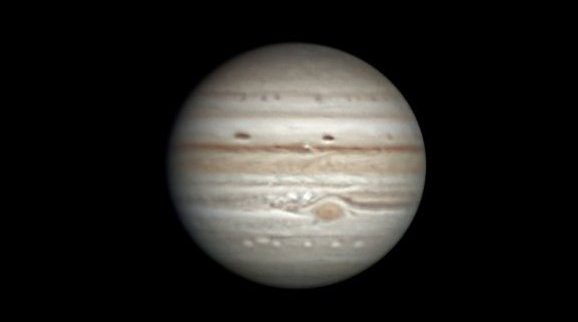
Jupiter has a long history of surprising scientists – all the way back to 1610 when Galileo Galilei found the first moons beyond Earth. That discovery changed the way we see the universe. Jupiter is, by far, the largest planet in the solar system – more than twice as massive as all the other planets combined.
Jupiter's familiar stripes and swirls are actually cold, windy clouds of ammonia and water, floating in an atmosphere of hydrogen and helium. Jupiter’s iconic Great Red Spot is a giant storm bigger than Earth that has raged for hundreds of years.
Jupiter Blog
 Dr. John Rogers at the British Astronomical Association has announced publication of their 7th report for the 2021-2022 apparition of Jupiter. This report highlight activity in Jupiter’s Equatorial region.
Dr. John Rogers at the British Astronomical Association has announced publication of their 7th report for the 2021-2022 apparition of Jupiter. This report highlight activity in Jupiter’s Equatorial region.
- Methane-bright patches in the EZ that are almost stationary in their CM III (L3) longitude
- Bright plume outbreaks seen in the unusually quiet NEBs with two recent outbreaks happening December 19th and January 9th.
Jupiter News Headlines
GRS Age in Dispute
6/19/2024
A new study published in Geophysical Research Letters suggests that Jupiter’s Great Red Spot we observe today has been around for about 190 years and is not the same feature observed by famed astronomer Giovanni Domenico Cassini in 1665. The authors used historical sources dating from the mid-1600s to analyze the evolution of the spot's size, structure and location over time. Their study also postulates some mechanisms that could have given rise to the Solar System’s most iconic super storm.
More information
Analysis of Jovian "Clyde's Spot"
3/25/2022
On May 31, 2020, an outbreak in Jupiter’s South Temperate Belt erupted and was first captured by amateur astronomer Clyde Foster of South Africa during one of imaging sessions of the giant planet. An analysis of “Clyde’s Spot” is presented in the July issue of Icarus detailing how small, convective storms can produce long-lasting effects over a broad area on Jupiter.
More information
Oceanographers Study Juno Data
1/10/2022

Giant cyclones around the poles of the solar system's largest planet are generated by the same forces that move water in Earth's oceans, a new study has found.
Jupiter's gargantuan polar cyclones, which are up to 620 miles (1,000 kilometers) across, were first spotted in 2016 by NASA's probe Juno. Since then, scientists have speculated that these storms are driven by convection, the process known from Earth in which hotter air expands and rises to higher, colder and denser altitudes. Until now, however, they couldn't prove the existence of this process on Jupiter.
Oceanographer Lia Siegelman, a postdoctoral researcher at Scripps Institution of Oceanography at the University of California San Diego, realized that those polar cyclones looked strikingly similar to ocean vortices that scientists study on our planet.
The analysis proved that rising hot air transports energy within the atmosphere and feeds the clouds as they grow into large-scale cyclones, such as those observed around the poles.
More information
Event Calendar
Dec 07, 2024
Jupiter at opposition
Mar 02, 2025
Jupiter at eastern quadrature

